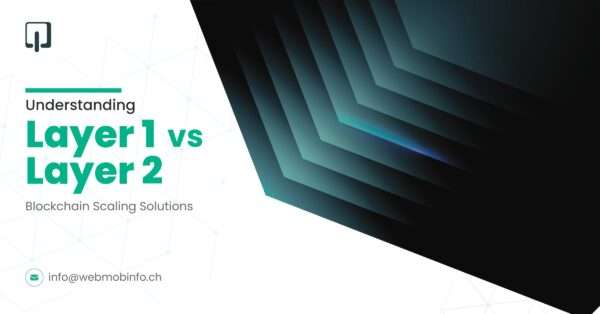Blockchain technology has emerged as a new frontier in the digital world, creating decentralized and secure solutions across sectors. Still, there are issues regarding scalability, which became complex as more users join the blockchain networks. This challenge has led to the development of two primary solutions: Layer 1 and Layer 2 blockchain scaling. It’s important to understand their differences and uses because they are fundamental for blockchain advancement and for any business related to blockchain development that aims to enhance the performance of the network.
TABLE OF CONTENT
What is Layer 1 Vs Layer 2 blockchain?
Layer 1 relates to the core layer of the blockchain structure. It encompasses the basic set of operations that provide the specifications of the blockchain network, consensus method, and transaction authorization. Layer 1 scaling solutions improve the native functionalities of the blockchain.
Layer 2, on the other hand, focuses on secondary protocols that are established on top of the primary blockchain. These solutions are off-chain, so they process transactions outside of the main blockchain, relying on Layer 1’s security and decentralization. Layer 2 scaling solutions are concerned with increasing the speed of transactions and reducing the cost without changing the base protocol.
Significance of Layer 1 and Layer 2 Scaling Solutions
With the uptick in the use of blockchain comes the need for more efficient and faster networks. Conventional blockchains such as Bitcoin and Ethereum have their disadvantages in terms of transaction rates and latency. These networks can be congested if the right scaling solutions are not in place, resulting in slow transactions and high fees. For that reason, companies that develop blockchain systems must research and implement Layer 1 and Layer 2 blockchain scaling solutions to retain the platform’s competitiveness and usability.
Layer-1 Blockchains & Their Scaling Solutions
Layer-1 blockchains are the fundamental infrastructure of any blockchain network since they consist of the core activities that characterize the network’s protocols, consensus algorithms, and transactions.
Some of the Layer 1 Blockchain Protocols
- Bitcoin
- Ethereum
- Solana (SOL)
- Avalanche (AVAX)
- Cardano (ADA)
- Cronos
Layer 1 Scaling Solutions:
Proof of Work (PoW) to Proof of Stake (PoS) Transition
The Level 1 scaling solution involves changes from Proof of Work (PoW) to Proof of Stake (PoS). Ethereum’s move to Ethereum 2 is a notable example. PoS is much more efficient in terms of energy consumption and can process more transactions in a second than PoW. This is a transition that is considered a significant step in the evolution of blockchain technology that seeks to address issues of scalability and sustainability.
Sharding
Another prominent Layer 1 scaling solution is sharding. It entails the partitioning of the blockchain into manageable pieces, which are commonly known as shards. Every shard works as a separate chain and handles its own transactions and smart contracts. This parallel processing increases the capability of the network, so it can process more transactions at once in the network. A blockchain development company can benefit by implementing sharding and increasing its network performance.
Block Size Increase
This is one of the simplest solutions to Layer 1 scaling, which is to increase the block size. More transactions are enabled in each block, or more transactions are processed per second in the network. However, this leads to centralization concerns as larger blocks take more storage and bandwidth, and fewer people can run a full node.
Layer-2 Blockchains & Their Scaling Solutions
Layer 2 scaling solutions are implemented as additional layers on top of Layer 1 blockchains, which provide an additional level that offloads the transactions from the main chain.
Some of the Layer 2 Blockchain Protocols
- Polygon
- Arbitrum
- Metis
- Optimism
- Loopring
- Starknet
- Eclipse
Layer 2 Scaling Solutions:
State Channels
State channels are one of the most popular Layer 2 scaling solutions. They enable two parties to transact many times off-chain; only the initial and final transactions are recorded on chain. This in turn helps to greatly decrease the load on the main chain, increase transaction speed, and minimize expenses. State channels are highly useful in scenarios that involve numerous micro-transactions.
Sidechains
Sidechains are additional chains that are interlinked with the primary chain through a two-way peg system. They allow assets to be moved from the main chain to the sidechain, which helps in handling some complicated operations off-chain. Sidechains can be viewed as a highly flexible Layer 2 scaling solution as they can be fine-tuned to fit the application’s needs.
Rollups
Transactions are grouped into rollups, which are then compacted into one transaction that is posted on the main blockchain. There are two types of rollups: Optimistic rollups and ZK-rollups (Zero-Knowledge Rollups). They both aim to increase productivity and decrease expenses. Optimistic Rollups take transactions as valid by default, while ZK-Rollups use proof to check the validity of the transactions. These solutions are popular in blockchain development due to their productivity and security.
Major Differences Between Layer 1 and Layer 2 Solutions
The main differences between Layer 1 and Layer 2 solutions can be found in their scaling strategies. Layer 1 solutions optimize the basic consensus algorithm, and Layer 2 solutions are designed to improve the transaction speed of the blockchain. Here are some key differences:
| Aspects | Layer 1 Solutions | Layer 2 Solutions |
| Modification | Refers to any alterations on the base blockchain. | Works on the existing layer without making changes to the base layer. |
| Transaction Handling | Process all the transactions taking place on-chain. | Handles Off-chain transactions to ease the congestion on the main chain. |
| Implementation Complexity | Requires consensus from the entire network, mostly difficult. | Much easier to implement with little or no changes to the base protocol. |
| Scalability | Enhances scalability through optimization of the primary blockchain. | Considerable expansion of the scalability is relatively rapid. |
| Transaction Speed | Improvement in transaction speed but still slow depending on the base protocol. | Transactional speed has been greatly enhanced. |
| Cost Reduction | Little change in the cost of transactions. | Greatly reduced cost of transactions. |
| Security & Decentralization | Sustains native security and decentralization. | Depends on Layer 1 for security and decentralization. |
| Flexibility | Less flexible since changes are applied to the whole network. | More scalable and can be fine-tuned according to the need. |
Final Thoughts
In the constantly developing world of blockchain, scalability is still an issue. Therefore, any businesses involved in blockchain development should understand the differences between Layer 1 and Layer 2 scaling and their uses. Both solutions are crucial for enhancing the capability of blockchain and the technology’s ability to accommodate more users or transactions. By using these scaling solutions, blockchain networks can overcome the limitations and continue to offer reliable, decentralized, and effective services.
Being one of the top blockchain development companies, Webmob Software is well-experienced in integrating Layer 1 and Layer 2 scaling solutions to improve your network’s performance and capacity. Get in touch with us for more details on how you can gain a competitive edge in the blockchain industry.
Chahat has a deep passion for leveraging blockchain technology to drive innovation and transformation. With over seven years of experience, she has been instrumental in guiding WebMob through the complexities of blockchain adoption. Her expertise and forward-thinking approach make her a key thought leader in the blockchain space, paving the way for a modern decentralized industry.

